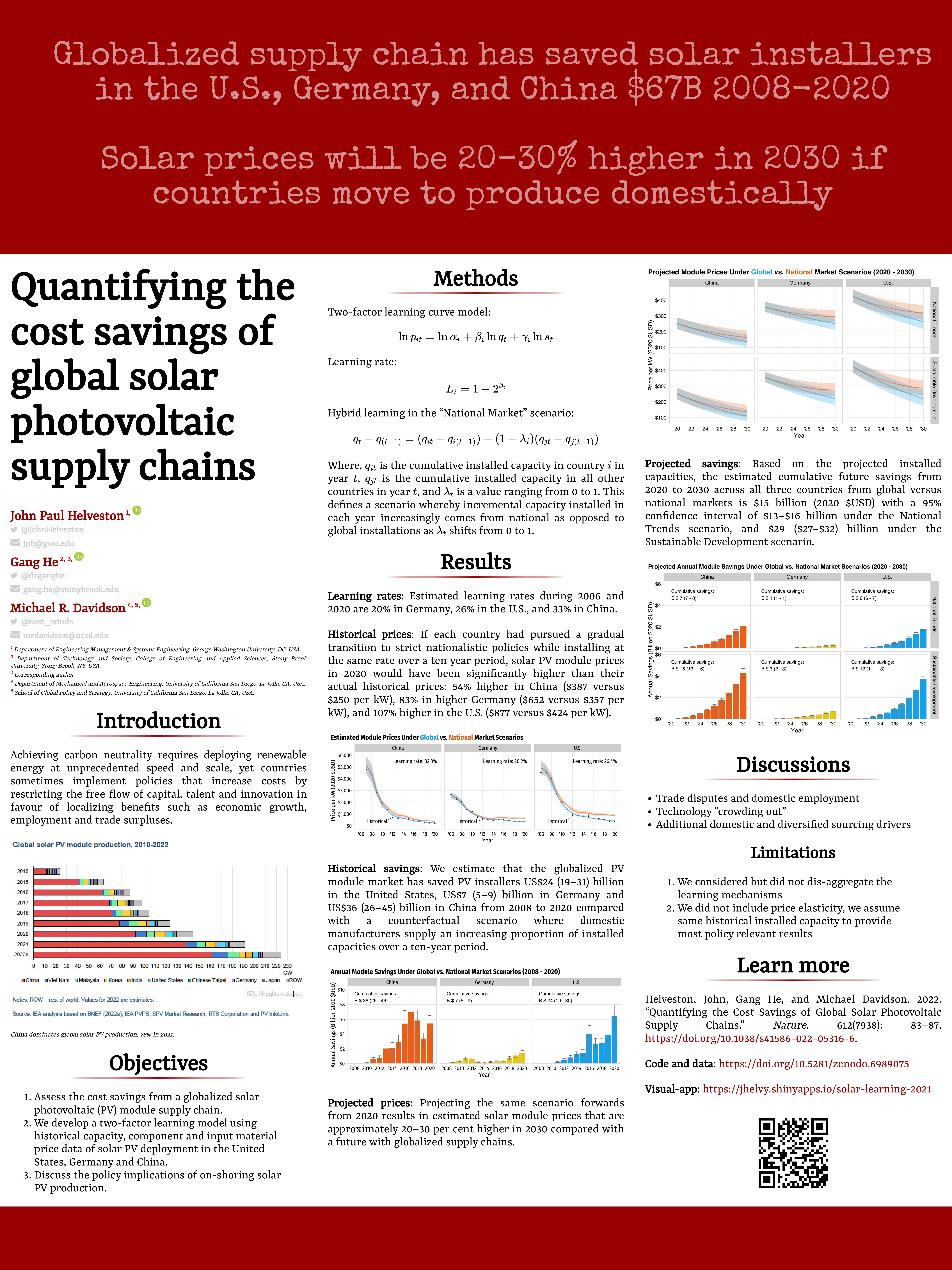Quantifying the cost savings of global solar photovoltaic supply chains
Nature
Quantifying the cost savings of global solar photovoltaic supply chains
John Paul Helveston, Gang He*, and Michael R. Davidson
Nature (2022)
DOI: 10.1038/s41586-022-05316-6
Abstract
Achieving carbon neutrality requires deploying renewable energy at unprecedented speed and scale, yet countries sometimes implement policies that increase costs by restricting the free flow of capital, talent and innovation in favour of localizing benefits such as economic growth, employment and trade surpluses. Here we assess the cost savings from a globalized solar photovoltaic (PV) module supply chain. We develop a two-factor learning model using historical capacity, component and input material price data of solar PV deployment in the United States, Germany and China. We estimate that the globalized PV module market has saved PV installers US$24 (19–31) billion in the United States, US$7 (5–9) billion in Germany and US$36 (26–45) billion in China from 2008 to 2020 compared with a counterfactual scenario where domestic manufacturers supply an increasing proportion of installed capacities over a ten-year period. Projecting the same scenario forwards from 2020 results in estimated solar module prices that are approximately 20–30 per cent higher in 2030 compared with a future with globalized supply chains. International climate policy benefits from a globalized low-carbon value chain, and these results point to the need for complementary policies to mitigate welfare distribution effects and potential impacts on technological crowding out.
Links
Published paper
Paper summary: The Cost of Going Solo in Solar
View-only SharedIt full-text
Preprint pdf
Github: solar-learning-2021
Zenodo: Code and Data
Shinyapps: Sensitivity visualization
Impact
Award: Integrated Assessment Modeling Consortium 2022 Best Poster Award
Nature Highlights: Climate policy: Solar energy expected to be cheaper through globalization
Joule Preview: The cost of risk mitigation—Diversifying the global solar PV supply chain by Nathan L.Chang, Mohammad Dehghanimadvar, and Renate Egan
Press release: SBU News, GWU News, UCSD News
Coverage: E&E News, Foreign Policy, GRID News, PV Magazine, dot.LA, pvbuzz, InnovateLongIsland, Mercom India, China News, Science and Technology Daily
Nature Portfolio Chinese summary
Notable policy citations:
UN, OECD, The World Bank, WTO and IMF. 2024. Working Together for Better Climate Action: Carbon pricing, policy spillovers, and global climate goals.
UK Parliament Select Committee Publications. 2024. Written evidence submitted by UK Trade for Net Zero.
World Bank. 2024. World Development Report 2024: The Middle-Income Trap.
International Renewable Energy Agency. 2024. Renewable energy and jobs: Annual review 2024.
World Trade Organization. 2023. Trade Policy Tools for Climate Action.
World Trade Organization. 2023. Global Value Chain Development Report 2023.
The World Bank reproduced our chart
Twitter Thread
Excited to share new paper in @nature with @JohnHelveston and @east_winds on “Quantifying the cost savings of global solar photovoltaic supply chains”.
— Gang He (@DrGangHe) October 26, 2022
Paper: https://t.co/2DpBh4huDj
pdf: https://t.co/F7oPjA67LR
Vis: https://t.co/a8Q306vnbq
More: https://t.co/OVmdOUHIfZ pic.twitter.com/oFg4hGf9YK
Poster
Here is the poster for IAMC2022 which won the Best Poster Award. The pdf is also available.

Slides
Above is the general slides of our paper, I presented it at Tsinghua University. Check the slides in a new tab.
Citation
@article{paul_helveston2022,
author = {Paul Helveston, John and He, Gang and R. Davidson, Michael},
title = {Quantifying the Cost Savings of Global Solar Photovoltaic
Supply Chains},
journal = {Nature},
volume = {612},
number = {7938},
pages = {83-87},
date = {2022-12-01},
url = {https://www.nature.com/articles/s41586-022-05316-6},
doi = {10.1038/s41586-022-05316-6},
langid = {en}
}


